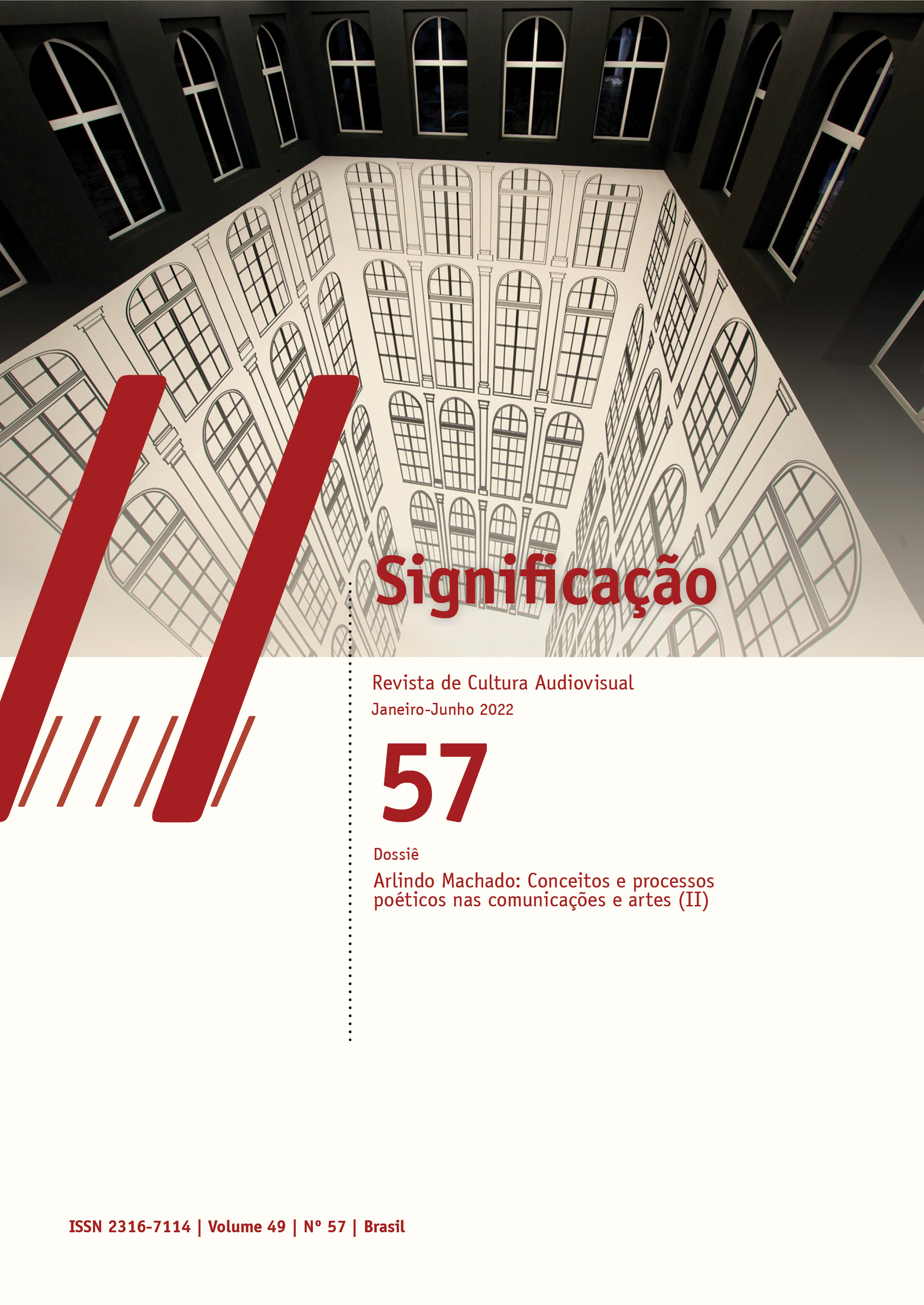Interiores: Wavelength (1967) e The living room (2000), de Michael Snow
DOI:
https://doi.org/10.11606/issn.2316-7114.sig.2022.184312Palavras-chave:
Cinema experimental, Michael Snow, Análise comparativaResumo
O artigo se debruça sobre o cinema de Michael Snow com foco no filme The living room (A sala de estar, 2000), realizado num período em que o cineasta utilizava tecnologias digitais de forma experimental e lúdica. A análise será guiada pelo método comparativo, cotejando o filme com trabalhos anteriores de Snow, sobretudo Wavelength (Comprimento de onda, 1967), marco do cinema estrutural, e com obras tanto de outros cineastas (Georges Méliès e Alfred Hitchcock) quanto de artistas visuais que trabalharam com mídias diferentes, como pintura e colagem. Verificaremos a hipótese de os filmes de Snow analisados representarem um regime escópico contemporâneo a que chamaremos, na esteira de Pascal Bonitzer, “perspectiva telescópica”, no intuito de demonstrar que a obra do cineasta extrapola o quadro de referências que lhe é usualmente atribuído e se reporta a uma crise da experiência perceptiva já colocada desde a modernidade visual do século XIX.
Downloads
Referências
AUMONT, J. Le montreur d’ombre. Paris: Vrin, 2012.
BAUDRY, J.-L. “Cinema: efeitos ideológicos produzidos pelo aparelho de base”. In: XAVIER, I. (org.). A experiência do cinema. Rio de Janeiro: Graal, 1983. p. 383-399.
BAZIN, A. O cinema: ensaios. São Paulo: Brasiliense, 1991.
BONITZER, P. Le champ aveugle: essais sur le cinéma. Paris: Gallimard, 1982.
BONITZER, P. Décadrages: peinture et cinéma. Paris: Editions de l’Etoile, 1987.
CALLOU, H. A. “A decomposição do tempo: as origens da duração no cinema experimental”. In: ENCONTRO ANUAL DA COMPÓS, 28., 2019, São Paulo. Anais […]. São Paulo, Compós, 2019.
CHABROL, C.; ROHMER, E. Hitchcock. Paris: Ramsay, 2011.
DUARTE, T. “O cinema estrutural norte-americano (1965-1972): sobre os debates em torno do termo”. In: DUARTE, T.; MOURÃO, P. (org.). Cinema estrutural. Rio de Janeiro: Aroeira, 2015. p. 42-61.
DUBOIS, P. O ato fotográfico. 14. ed. Campinas: Papirus, 2012.
FLEISCHER, A. “La cinémachine de Michael Snow”. In: DAMISCH, H. et al. Michael Snow: Panoramique. Bruxelles: Cinémathèque Royale de Belgique, 1999.
FOUCAULT, M. As palavras e as coisas. 9. ed. São Paulo: Martins Fontes, 2007.
GAUDREAULT, A. “Theatricality, narrativity, and trickality: reevaluating the cinema of Georges Méliès”. Journal of Popular Film and Television, Marquette, v. 15, n. 3, p. 110-119, 1987.
GUNNING, T. “‘Nothing will have taken place – except place’: the unsettling nature of camera movement”. In: SÆTHER, S. Ø.; BULL, S. T. (org.). Screen space reconfigured. Amsterdam: Amsterdam University Press, 2020. p. 263-280.
MICHELSON, A. “About Snow”. October, Cambridge, n. 8, p. 111-125, 1979.
MICHELSON, A. “Toward Snow”. In: SITNEY, P. A. (org.). The avant-garde film: a reader of theory and criticism. New York: New York University Press, 1978.
NOGUEZ, D. “Sur la longueur d'onde de Michael Snow”. In: SAYAG, A. (org.). Michael Snow. Paris: Centre Pompidou, 1978.
PANOFSKY, E. Perspective as symbolic form. New York: Zone Books, 1991.
PENLEY, C. The future of an illusion: film, feminism, and psychoanalysis. Minneapolis: University of Minnesota Press, 1989.
POGGI, C. “Frames of reference: “table” and “tableau” in Picasso’s collages and constructions”. Art Journal, New York, v. 47, n. 4, p. 311-322, 1988.
SITNEY, P. A. “Structural film”. Film Culture, New York, n. 47, p. 1-10, 1969.
SITNEY, P. A. “O cinema estrutural”. In: DUARTE, T.; MOURÃO, P. (org.). Cinema estrutural. Rio de Janeiro: Aroeira, 2015. p. 10-38.
SITNEY, P. A. Visionary film: the American avant-garde: 1943-1978. 2. ed. Nova York: Oxford University Press, 1979.
SNOW, M. “Notes sur Wavelength pour le festival du film expérimental de Knokke-le-Zoute (1968)”. In: SNOW, M. Des écrits: 1958-2001. Paris: Centre Pompidou, 2002.
TURVEY, M. “The child in the machine: on the use of CGI in Michael Snow’s *Corpus Callosum”. October, Cambridge, n. 114, p. 29-42, 2005.
WEES, W. C. “Prophecy, memory and the zoom: Michael Snow’s Wavelength re-viewed”. Ciné-Tracts, Montreal, n. 14-15, p. 78-83, 1981.
Referências audiovisuais
NOTORIOUS (Interlúdio). Alfred Hitchcock, Estados Unidos da América, 1946.
SSHTOORRTY (Sshtoorrty). Michael Snow, Canadá, 2005.
THE living room (A sala de estar). Michael Snow, Canadá, 2000.
WAVELENGTH (Comprimento de onda). Michael Snow, Estados Unidos da América-Canadá, 1967.
Downloads
Publicado
Edição
Seção
Licença
Copyright (c) 2022 Luiz Carlos Oliveira Junior

Este trabalho está licenciado sob uma licença Creative Commons Attribution-NonCommercial 4.0 International License.
Autores que publicam nesta revista concordam com os seguintes termos:- Autores mantém os direitos autorais e concedem à revista o direito de primeira publicação, com o trabalho simultaneamente licenciado sob a Licença Creative Commons Attribution que permite o compartilhamento do trabalho com reconhecimento da autoria e publicação inicial nesta revista para fins não comerciais.
- Autores têm autorização para assumir contratos adicionais separadamente, para distribuição não-exclusiva da versão do trabalho publicada nesta revista (ex.: publicar em repositório institucional ou como capítulo de livro), com reconhecimento de autoria e publicação inicial nesta revista.
















